Bienvenidos a Ecuador!!
(steve)
Who wants to go visit South America? We do, we do!! To satisfy the itch, Karen and I convinced two of our LA friends to join us on a two week tour of the beautiful South American country of Ecuador. After an agonizing decision process, we chose an action packed adventure tour sure to keep us moving and needing a week of recovery time back at work.
Since we just couldn't wait, Karen and I flew down a couple of days early to visit the Bellavista Cloud Forest Reserve. Situated two hours northwest (by car) from the capital city of Quito, Bellavista is a privately owned bird sanctuary in a country known for its biodiversity. (In fact, only Brazil and Columbia have more identified bird species in the world.) Located within the cloud forest region of the Andes at about 7,000 ft altitude, Bellavista is home to a dazzling array of hummingbirds. Each day, the staff at the Reserve fill a series of large feeders to coax the hummingbirds out of the forest for all to see. The result is a hectic frenzy of whirring birds pushing past each other to get a choice spot (males being territorial buggers). At any one time there may be over twenty birds flitting between nearby branches and feeders. In addition, the hummingbirds are not particularly afraid of people and willing to let you get in really close for a good look.
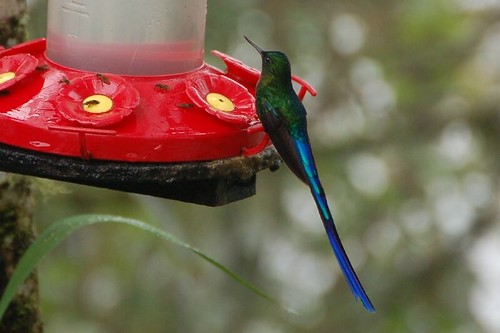
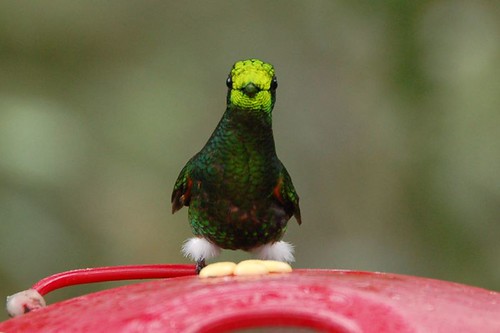
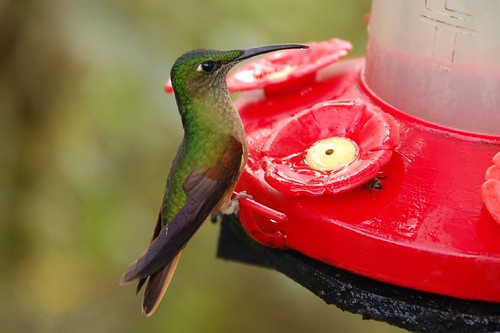
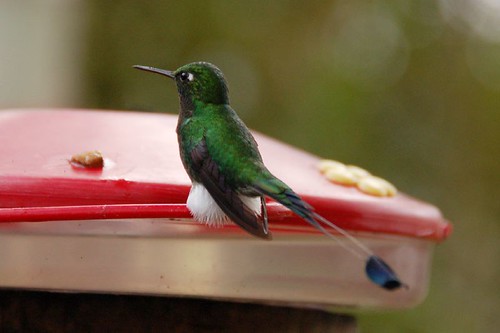
While staying at the Reserve, we managed to get out and explore the surrounding sub-tropical forest looking for other critters and plants. There were a multitude of trails to choose from, most requiring hiking up and down steep, muddy hills (out favorites). There is a vitality about tropical forests that is amazing to see, with plants battling for supremacy. The distinguishing feature of a cloud forest is the constant presence of misty clouds that move over and through the trees, sometimes a large bank, sometimes a single puff. The cloud forest is also home to a large array of interesting flowers like the Birds of Paradise and beautiful orchids. And what tropical forest would be complete without epiphites?
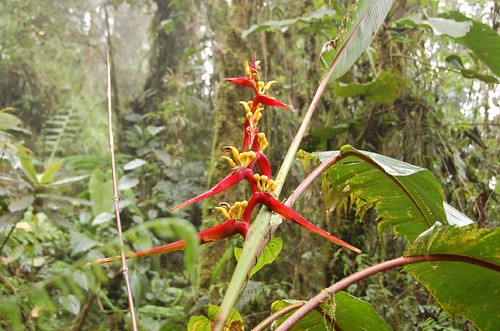
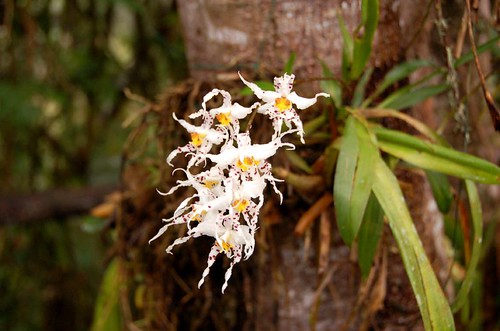
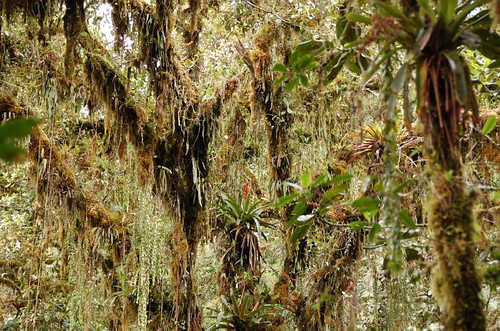
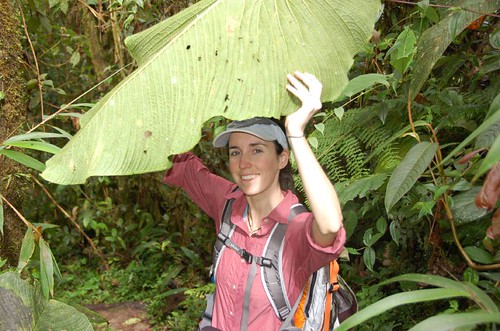
Not to be outdone, we also encountered a few of the bigger bird species, notably trogans, mountain tanagers, and a gorgeous mountain toucan.
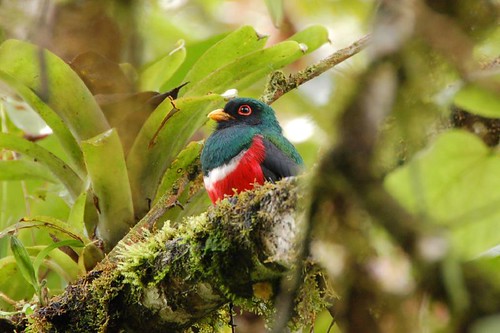
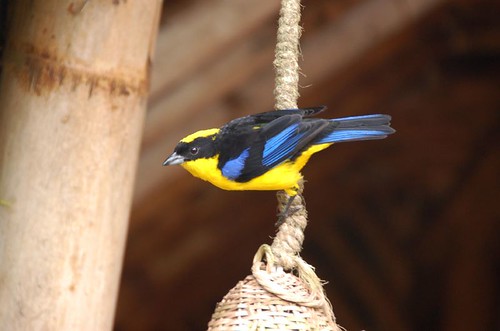

After two days of bird watching, we returned to Quito to meet up with our friends Suzanne and Mindy, and join our tour group for the rest of the trip. A joyful reunion was celebrated on the streets of Quito. We wandered around the city, visiting the Centro Historico to see the Presidential Palace, Grand Plaza, City Cathedral, and Ejido market. There was a little consternation about the local water, but Karen decided to buck the trend and eat local fruit (looked similar to cherry tomatoes, but orange) bought from an open air market and eat it straight away. Luckily, there was no Ecuadorian revenge experienced, so the rest of us tried the fruit the next day. Since we live in next to the Rocky Mountains, the 9,500 ft altitude didn't bother us much, but our LA compatriots were definitely winded climbing the steep streets.
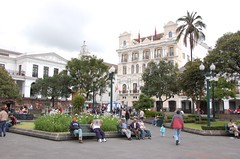
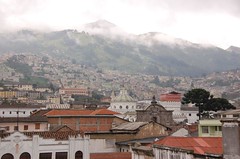
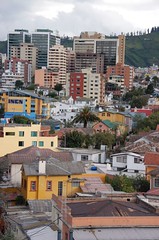
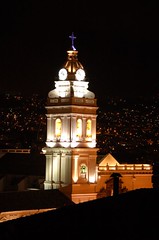
That first day in Quito was made more interesting by the complete lack of English around us. It must have been amusing (or annoying) for the locals to watch the four of us huddle together to come up with simple phrases dredged up from Spanish classes a decade ago. I must admit, it was amazing how fast vocabulary returned when confronted with no other means of communication besides pointing. (I would say by the end of the two weeks, we were minimally functional in Spanish again and inspired to relearn for the next trip.) I have to thank the locals for their patience and good humor.
The next morning we embarked, with the rest of our tour, on a series of adventure sports that showcased the amazing Andes mountains with its range of volcanoes and rivers. First up, mountain biking. To warm up, we drove to 14,500 ft to ride down the Cotapoxi volcano. From the parking lot near the beginning of a snow field, we braved a fierce wind to sail down the mountain on a dirt road, passing some free range llamas along the way.
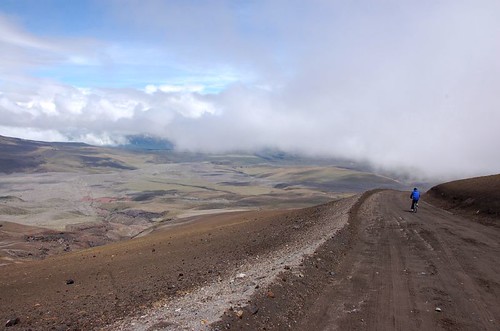
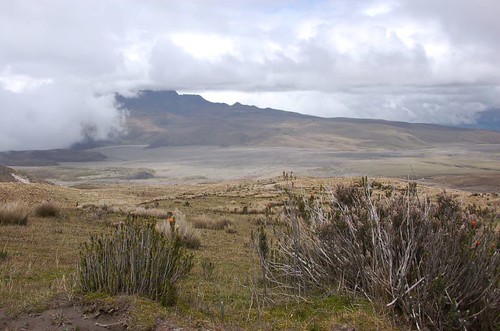

From Cotapoxi, we drove to the town of Urbina for a stay at a converted train station. Along the way, we received a great view of the nearby erupting volcano, Tungurahua. The "station house" was a quaint house in the countryside, complete with local livestock to play with. Here, we were provided with the first extended conversations with our fellow travelers. We got along all right with most everyone, but didn't find any instant buddies among the throng.


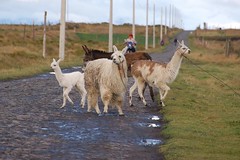
The second day of biking was more serene, past rolling hills and farms in the countryside south of Quito. At first the ride was a bit bumpy over cobblestones, but a downpour quickly converted the ensuing dirt roads to mud. We ended up quite covered (not readily apparent from the photo), but no worse for wear. During the second half of the day, Karen and I managed to get separated from the group, and were surprised to find ourselves behind the chase van after a somewhat frantic bit of peddling. They were a bit surprised to see us go flying by and waving. It's a good thing there were local school children around to tell us which way the rest of the gringos went.
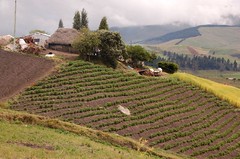
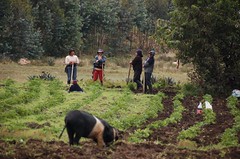
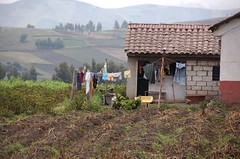


After drying out, we had a rest day in town of Riobamba. What better way to rest than a nice hike to 17,000 ft (starting from 15,000 ft) on the country's tallest volcano, Chimborazo. Here we joined hiking guide, Rodrigo, to go higher than our feet have ever taken us before. We followed a trail that led to the summit (over 20,000 ft), but ended up turning back when a snow storm began and the rocks got slippery. We were completely bundled up while Rodrigo wore jeans and sneakers.
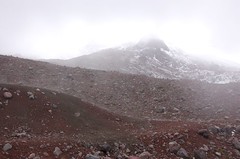

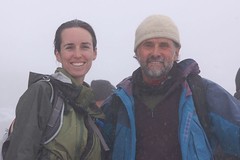
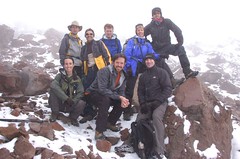
Feeling refreshed, we hopped a bus to the Guamote market. Here we visited a truly local market with little evidence of tourist infiltration. The locals flocked from nearby villages and farms to trade wares, including animals, food, and all manner of necessities. In this area, the local dress was highlighted with vibrant colors, particularly for the women. The signature fedora-style hat was worn by many. Rodrigo led us around like little ducklings (which were for sale next to the pigs), pointing out interesting items. We ended up buying a few bananas (peeled fruit is usually ok) for the road and they were really good.
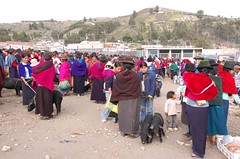
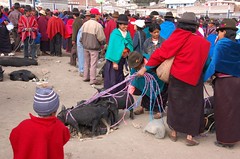
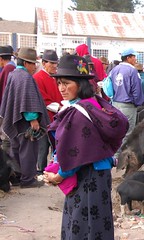
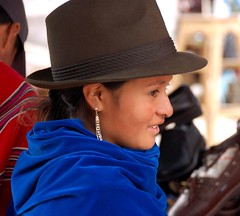
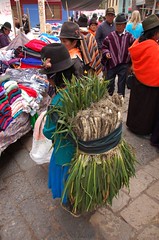
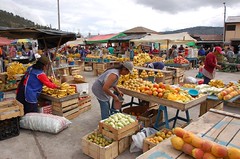
Our next adventure commenced in the town of Achepullas (12000 ft) for a three day hike along the Ecuadorian Inca trail to the ruins of Ingapirca. For the entire hike, we followed a little visited trail along the Andean high country where our only company was a handful of hardy farmers and shepherds (with flocks), and our train of trusty mules. All three days were filled with dramatic vistas of high peaks and deep valleys, with swirling clouds forming in valleys below. To keep us on our toes, occasional bogs appeared with little warning (see photo of Suzanne). Coming from the arid Rocky Mountains, the lush green of the Ecuadorian highlands felt a little strange, but the beauty of the hills was definitely worth the lack of oxygen and windy afternoons. (We spent the entire hike above 12,000 ft altitude, with almost a full day above 14,000.) The first night, Karen and I followed Rodrigo up a nearby peak after dark. We summited over 14,000 ft with our headlamps on after 90 minutes of steady climbing. (One of our other guides chased after us for fun and made the same climb in 41 minutes.) Coming down was more challenging as a light rain started and the rocks and thatch got a little slippery. Our final arrival time to camp was close to midnight. While brushing my teeth after arrival, I strolled just outside the camp and encountered a big glowing set of eyes about 50 ft away. As I stopped to look, the unmistakable profile of a mountain lion appeared from the darkness. After a long glance, the cat sauntered off towards the hills, and I raced back to the tents. No one else ended up seeing the beast. Rodrigo told me the next morning it must have been a goat or a donkey, but I know what I saw and it wasn't no goat.
Our second day of hiking followed a dramatic ridge line that allowed great views into valleys on either side. Here we spied a group of bulls roaming free on a lower hillside, awaiting their turn to face off with matadors in the ring. This day ended up being a long, hard walk, leaving most of the group ready to be done and off to bed early. Although, Rodrigo convinced Karen and I to go on another walk after dinner to find birds at a lake near the camp.
The hiking ended in the ruins of Ingapirca, an important Incan religious site. Here we toured the perfectly constructed walls of the Temple of the Sun, with joints so smooth you couldn't put a coin between the blocks. There were numerous outlines of rooms, walls, and storage areas, indicating that this area was considered important to the Incas over 400 years ago. It was interesting to learn more about the Inca and how they influenced the local culture despite only governing Ecuador for 60 years before the arrival of the Spaniards.
Sore of feet, we all climbed on the bus for a ride to the town of Banos at the foot of Tungurahua (that's right, the erupting one). Along the way, we traveled along part of the Pan American highway, the road connecting Alaska with the southern tip of Chile. This particular section of road was a bit hairy, as landslides had covered both lanes recently, and the local government was a bit slow to respond. The comment from Rodrigo, "this is more like a trail than a road right now." We were informed that even simple construction jobs in Ecuador can take years to complete due to lack of funding.
Upon arrival in Banos we were instructed to keep a bag of valuables and clothes at the ready, in the event of serious eruption. The evacuation instruction was less than encouraging: "follow the townspeople, they know where to go." To keep our minds off of eruptions, Karen and I went on an optional canyoning trip. In case you're wondering, canyoning involves rappelling down flowing waterfalls surrounded by canyon walls. In this case, we descended down four consecutive waterfalls, the highest about 60 feet. (Unfortunately no pics since cameras don't like water). Our guides were both about 18 years old and spoke broken English, but seemed to know their stuff, despite using the van as the first anchor (I made sure to check the emergency brake was on). After drying out (again), Karen and I hiked up another trail to a great overlook of the city. Along the way, we saw a very funny sign informing us of our need to buy a beer.
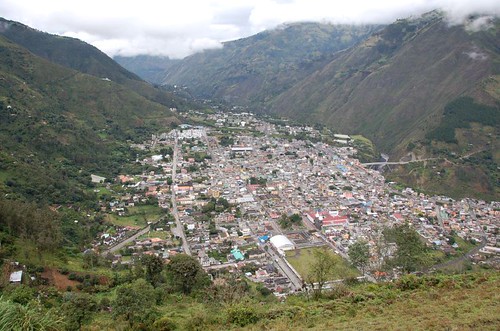
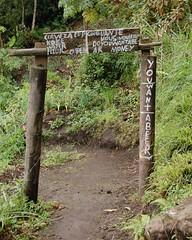
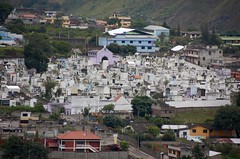
From Banos, we boarded yet another bus for the ride to Tena. This bus ride was different from others so far, since we were descending to the edge of the Amazon rain forest at 2,000 ft altitude. The town of Tena was the starting point for three days of whitewater rafting. Day 1 was on the Tena river (class 3 rapids), with lots of lazy paddling and fun raft games in between the rapids. Our boat contained me, Karen, Mindy, Suzanne, and Susanna (another American), with our hulking guide Santiago (aka Tigre). Tigre turned out to be a really good guy and we ended up using his call "Ok, my team, forward, hard, hard, hard" (imagine spanish accent) for the rest of the trip. At the end of the day, we gathered in one of the three decent restaurants in Tena for a celebratory dinner followed by ice cream. Once again, Karen tested her luck by playing with a local stray dog. He was really cute, but cute dogs get rabies too.
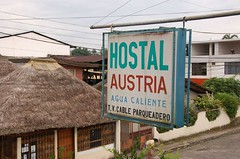
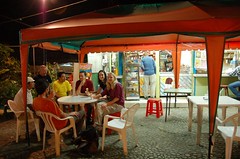
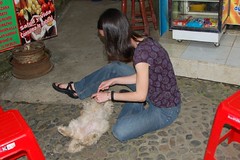
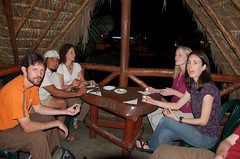
After ice cream, the head rafting guide, Tarquino, led us to a local bar where we enjoyed the atmosphere and forced Karen to take a tequila shot. The night turned interesting when Tarquino decided to try his luck at wooing Mindy, inviting her to salsa dance. The special treatment continued the following day when he sat next to her for a long bus ride and they giggled while trading stories. Unfortunately, Tarquino was spurned, despite the 7 marriage proposals (but I digress).
The second rafting day was on a different river to the north of Tena (I forget the name, but class 3+ rapids). Before entering the boats we slogged through a mile of shin deep mud (being passed by horses toting bananas the other direction). The rafting this day was much more technical for the first half, dodging rocks and getting snagged multiple times. Karen and I spent the calm times gazing a waterfalls and searching the trees for oropendolas with their distinctive teardrop shaped nests hanging from high tree limbs. (These were favorite birds from our Belize trip). We found quite a few nests, and saw a group of oropendolas pass overhead.
Our final day of rafting was on the Quijos river (class 4/5 rapids). Here our skills were put to the test on a section of river used for the World Cup rafting championship in 2006 (Ecuador placed 20th out of 25). To begin, we were all forced to float a set of class 3 rapids in our life jackets so we could feel the power of the river (and convince the guides we wouldn't panic when we fell overboard). From then on, Tigre guided us through one exciting rapid after the other, with little time to rest and look around in between. One fun episode for us was watching the "boy boat", filled with four cocky guys, flip in a rapid because they were messing around. The climax to the day came in the form of the big rapid named "El Toro". We got out of the boats to scout the river and get instructions from Tigre. El Toro was so named due to the enormous rock sitting in the middle of the current. The goal was to aim for the rock and just miss, while not getting stuck in the huge eddy just behind it.
Once back on board, our boat was chosen to shoot the rapid first. We began with the desired line, following encouraging yells from Tigre. Unfortunately, at a critical moment, our boat hit something and spun 180 degrees, leaving us tail first toward the enormous rock. Tigre fought valiantly and managed to get us to miss the rock, but we couldn't avoid the eddy and were immediately sucked in. At this point we were at the mercy of the water, waiting to flip and get pulled under water. This condition lasted for a few seconds, where I might add I ended up laying on the side of the boat, but didn't fall in the river by some miracle, since I wasn't holding anything except a paddle and my feet were up in the air. The next moment, our boat was ejected from the eddy by some masterful paddling from Tigre and we spun off down the river. After catching our breaths, we were left to wonder exactly what had happened, but were exhilarated nonetheless. Our effort was validated when the "boy boat" promptly dumped all its passengers into the river during their transit of the rapid (for a total of three dumps in three days).


Following our adrenalin adventure, a rest was prescribed in the hot springs of Papallacta where we spent the afternoon bathing in deliciously warm water. The evening was spent relaxing with a glass of wine and enjoying a good meal. The next morning we strolled around outside the resort and found some more local livestock to harass.
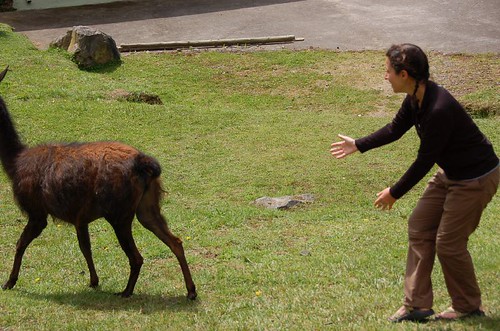
The final day of the tour ended with the market in Otavalo. This market is known as the largest indigenous market in South America, taking up over 8 square blocks of city streets. For most of us, this was a chance to wander the booths and purchase souvenirs, testing our haggling skills. It turns out, this was Mindy's day to shine. We knew she liked to shop for goods in foreign countries, but my goodness, did she shop. I've never met a more relentless haggler. To her credit, she never paid more than she wanted and she came home with just about everything on her list and more.
Back to the market. Otavalo market was divided into two sections, a local food/animal market, and the tourist section. We were struck immediately by the different local dress in Otavalo. Here, the women wore black skirts and shawls and white blouses, with a turban sort of hat and gold necklaces. Very different from further south.
While perusing the goods, Karen, Mindy, and I decided to have lunch from a local vendor. We were served two heaping plates of rice, chicken, pasta, and potato fritters for a whopping $2.30. The food was great and we sat next to an extremely cute older couple who smiled at us as they ate their soup.
With our bags heavier and wallets lighter, we journeyed back to Quito to finish up our trip. The final night ended with a group dinner and Mindy, Suzanne, Karen, and me back in the hotel room to reminisce over all we had done. This trip was definitely one to remember, full of action, culture, and beautiful scenery. It's safe to say we were smitten with South America and intend to return in the not-so-distant future.
ps. I hope the length and content of this post makes up for the lack of writing for the past months :)
pps. I can see I left out hordes of details so here a few last tidbits: Ecuador uses the US dollar for currency, we ate enough fried eggs for breakfast to last a lifetime, the drivers in Ecuador are absolutely crazy (imagine passing three wide on a two lane road on a blind curve in the mountains), there weren't too many leafy vegetables to be had but loads of potatoes and pork, I was much taller than most of the locals, Quechua (indigenous language) is extremely different from spanish so most rural Indians can't understand city dwellers, fried pork skin soup is actually pretty good...
Labels: bellavista, ecuador, ingapirca


0 Comments:
Post a Comment
<< Home